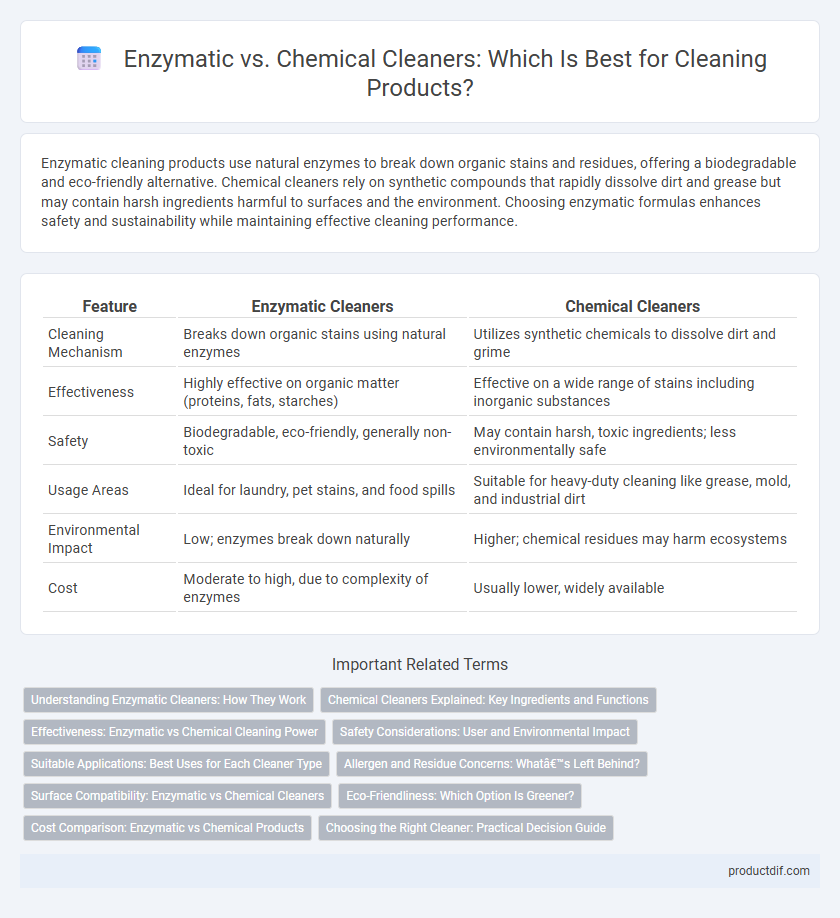Enzymatic cleaning products use natural enzymes to break down organic stains and residues, offering a biodegradable and eco-friendly alternative. Chemical cleaners rely on synthetic compounds that rapidly dissolve dirt and grease but may contain harsh ingredients harmful to surfaces and the environment. Choosing enzymatic formulas enhances safety and sustainability while maintaining effective cleaning performance.
Table of Comparison
| Feature | Enzymatic Cleaners | Chemical Cleaners |
|---|---|---|
| Cleaning Mechanism | Breaks down organic stains using natural enzymes | Utilizes synthetic chemicals to dissolve dirt and grime |
| Effectiveness | Highly effective on organic matter (proteins, fats, starches) | Effective on a wide range of stains including inorganic substances |
| Safety | Biodegradable, eco-friendly, generally non-toxic | May contain harsh, toxic ingredients; less environmentally safe |
| Usage Areas | Ideal for laundry, pet stains, and food spills | Suitable for heavy-duty cleaning like grease, mold, and industrial dirt |
| Environmental Impact | Low; enzymes break down naturally | Higher; chemical residues may harm ecosystems |
| Cost | Moderate to high, due to complexity of enzymes | Usually lower, widely available |
Understanding Enzymatic Cleaners: How They Work
Enzymatic cleaners use biological enzymes like protease, amylase, and lipase to break down organic stains by catalyzing the decomposition of proteins, starches, and fats, making them highly effective for removing food, blood, and grease. Unlike chemical cleaners that rely on harsh synthetic ingredients for surface-level cleaning, enzymatic cleaners target and digest the molecular structure of stains at a microscopic level, enhancing stain removal and reducing residue. The natural enzymatic action also supports eco-friendly cleaning by minimizing the need for strong chemicals and reducing environmental impact.
Chemical Cleaners Explained: Key Ingredients and Functions
Chemical cleaners rely on synthetic compounds such as surfactants, solvents, and acids to break down dirt, grease, and stains efficiently. Surfactants reduce surface tension, allowing the cleaner to penetrate and lift grime, while solvents dissolve oily residues, and acids remove mineral deposits and rust. These key ingredients work synergistically to deliver powerful cleaning performance across a variety of surfaces and applications.
Effectiveness: Enzymatic vs Chemical Cleaning Power
Enzymatic cleaners break down organic stains like proteins, fats, and carbohydrates through natural catalysts, making them highly effective for biological messes and reducing surface residue. Chemical cleaners rely on strong synthetic agents such as surfactants, solvents, or bleaches to dissolve dirt, grease, and stains quickly, often providing faster results on inorganic messes. The choice between enzymatic and chemical cleaning power depends on the specific type of stain or soil, with enzymatic cleaners excelling at biological materials and chemical cleaners performing better on inorganic contaminants.
Safety Considerations: User and Environmental Impact
Enzymatic cleaning products offer enhanced safety for users and the environment by utilizing natural enzymes that break down organic matter without harsh chemicals, reducing skin irritation and respiratory risks. Chemical cleaners often contain synthetics like ammonia or chlorine, which can cause toxicity and environmental pollution through water contamination and air emissions. Choosing enzymatic formulas minimizes exposure to hazardous substances, promotes biodegradability, and supports safer waste management practices.
Suitable Applications: Best Uses for Each Cleaner Type
Enzymatic cleaners excel in breaking down organic stains such as food, blood, and pet waste, making them ideal for household kitchens, healthcare settings, and laundry. Chemical cleaners, with their strong disinfectant properties, are best suited for sanitizing surfaces, removing grease, and tackling tough dirt in industrial and commercial environments. Choosing the right cleaner depends on the specific cleaning task and the type of soil or contamination present.
Allergen and Residue Concerns: What’s Left Behind?
Enzymatic cleaning products break down proteins, starches, and fats, effectively minimizing allergen residues in environments sensitive to asthma and skin reactions. Chemical cleaners often leave behind synthetic residues that can trigger allergies or irritate sensitive skin, raising concerns for households with allergy sufferers. Choosing enzymatic solutions reduces the risk of residual allergens and promotes a safer, hypoallergenic cleaning environment.
Surface Compatibility: Enzymatic vs Chemical Cleaners
Enzymatic cleaners break down organic stains using natural enzymes, making them highly compatible with delicate surfaces such as fabrics, wood, and upholstery without causing damage. Chemical cleaners rely on harsh solvents or acids that can degrade or discolor sensitive materials, limiting their use to hard surfaces like tile or metal. Selecting an enzymatic cleaner ensures safer cleaning for porous or sensitive surfaces, while chemical cleaners provide stronger results on non-porous, resilient materials.
Eco-Friendliness: Which Option Is Greener?
Enzymatic cleaning products utilize natural enzymes to break down organic stains and waste, resulting in a biodegradable and non-toxic solution that minimizes environmental impact. Chemical cleaners often contain harsh synthetic compounds and solvents that can persist in ecosystems, contributing to pollution and harming aquatic life. Choosing enzymatic cleaners supports sustainability goals by reducing chemical runoff and promoting safer waste decomposition compared to conventional chemical alternatives.
Cost Comparison: Enzymatic vs Chemical Products
Enzymatic cleaning products often have a higher upfront cost compared to traditional chemical cleaners, but they provide cost savings over time due to lower usage quantities and reduced environmental disposal fees. Chemical cleaners are generally less expensive per unit but may require more frequent application and carry higher long-term costs related to health and environmental impacts. Evaluating cost-effectiveness involves considering not only purchase price but also efficiency, safety, and regulatory compliance expenses.
Choosing the Right Cleaner: Practical Decision Guide
Enzymatic cleaners use biological enzymes to break down organic stains, making them highly effective on protein-based messes like food, blood, and pet accidents. Chemical cleaners rely on synthetic compounds to dissolve dirt and grime, offering faster action on grease and mineral deposits. Selecting the right cleaner depends on the type of stain and cleaning surface, where enzymatic formulas suit organic residues and chemical products excel in cutting through tough, inorganic contaminants.
Enzymatic vs Chemical Infographic

 productdif.com
productdif.com